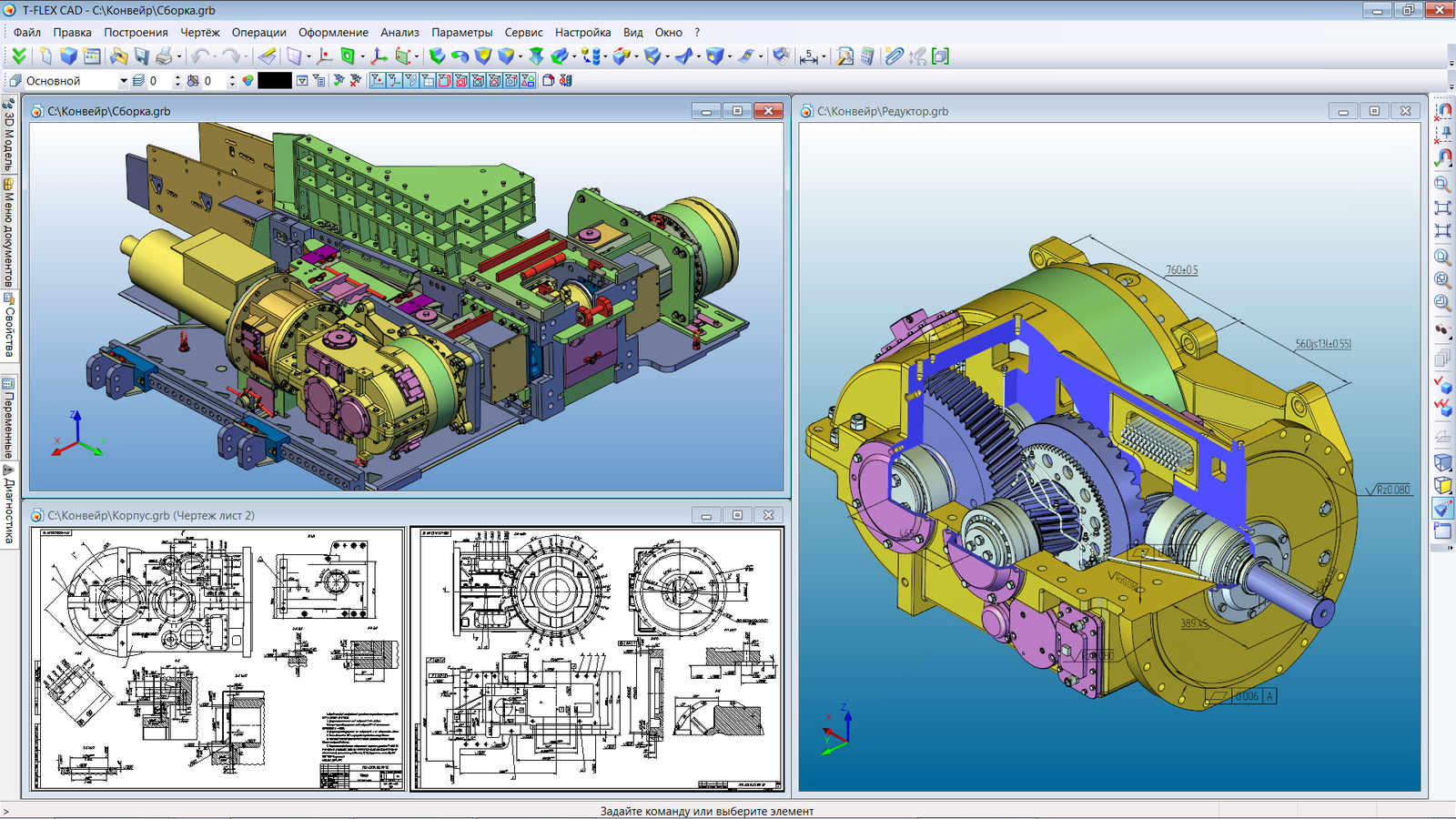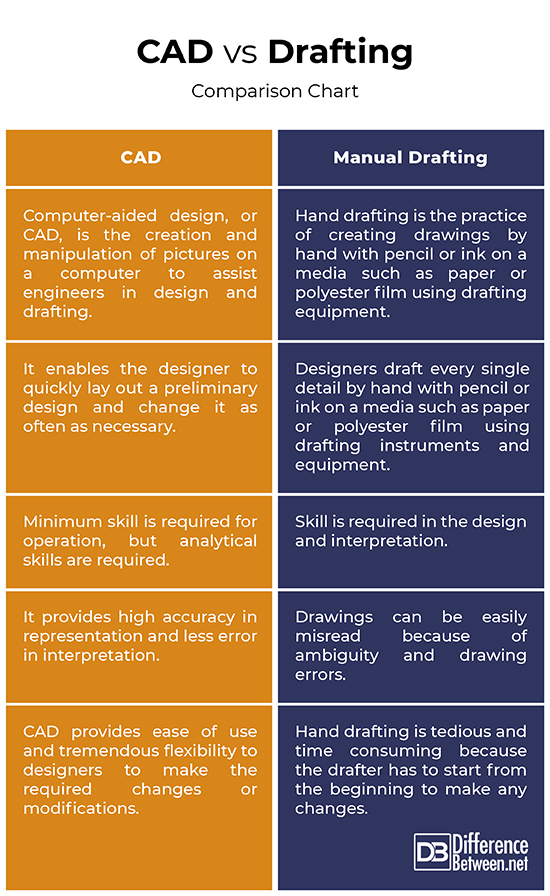Difference Between CAD and Drafting
Computer-aided design and drafting systems have received a great deal of recognition over the past few years regarding increased design and drafting productivity. Computer-aided design and drafting systems, or in short CAD, most often meet those expectations. Traditionally it is done by manual drawings using tools such as pencil or ink on a media such as paper or polyester film using drafting instruments and equipment. Today, advanced technologies and sophisticated software such as CAD software programs made it all switched to a whole new paradigm, called computer-aided design.

What is Computer-Aided Design (CAD)?
CAD, short for computer-aided design and drafting (CADD), as opposed to hand drafting, is the use of computers to assist designers in design, development, and revision work. The need to meet the design and manufacturing requirements of aerospace industries after the World War II has led to the development of the technology. CAD owes its development to the APT language project at MIT in the early 1950’s. Due to its various facilities and advantages, CAD has become an essential tool for designers for creation of optimized design within the scheduled time. CAD is a software program used to design a product and document the design process using 2D or 3D computer models. A CAD drawing is a file that consists of numeric data in binary form that will be saved onto a disk. Traditional drafting is repetitive and can be inaccurate at times. Larger and more complex drawings are drawn more efficiently with CAD.

What is Hand Drafting?
Manual drafting or hand drafting is the practice of creating drawings by hand with pencil or ink on a media such as paper or polyester film using drafting instruments and equipment. Drafting by hand has traditionally enabled the planning and communication of design ideas. In manual drafting, different details of the drawing can be drawn on different sheets of paper or overlays. Each overlay is then perfectly aligned with the others. All of them are placed on top of each other and then you can reproduce the entire drawing. Traditional drafting is repetitive and can be inaccurate at times. The advent of more efficient and effective software technologies such as CAD has made design and drafting easier and less time consuming.
Difference between CAD and Manual Drafting
Definition
– Hand drafting, or manual drafting, is the practice of creating drawings by hand using tools such as drafting table, technical tools, templates, drafting instruments and equipment, etc. Hand drafting was the preferred choice among professionals for a very long time. But the advent of more efficient and effective software technologies including computers, man-machine interface devices, sophisticated software such as CAD have made design and drafting easier and less time consuming. CAD is the creation and manipulation of pictures on a computer to assist engineers in design and drafting.
Technique
– In manual drafting, architects and engineers draft every single detail by hand with pencil or ink on a media such as paper or polyester film using drafting instruments and equipment. Proper line width and darkness are necessary to produce a quality drawing, and many familiar symbols are also used on drawings. CAD is a software package used to design a product and document the design process using 2D or 3D computer models. CAD provides various geometric models such as patterns, symbols and diagrams for representation of products to realize abstracted ideas in designer’s mind.
Productivity
– CAD refers to the entire spectrum of drawing with the aid of a computer, from straight lines to color animation. CAD facilitates many aspects of the design process; it increases the productivity of the designer throughout the whole design process and improves the quality of the design with more complete analysis ability, thereby reducing the design time significantly and hence the productivity. Thanks to the elaborate design tools, designers can test more alternatives to find the optimal solution based on the customer’s needs.
Ease of Use
– Larger and more complex drawings are drawn more efficiently with CAD. Due to its various advantages, CAD becomes an essential tool for designers for creation of optimized design within the scheduled time. Moreover, CAD facilitates automation for reduction of repetitive work, mechanism analysis and tracing of curves, and animation for presentation. Design changes are often necessary in order to find the optimal solution based on client’s preferences. CAD provides ease of use and tremendous flexibility to designers to make the required changes or modifications.
CAD vs. Drafting: Comparison Chart

Summary of CAD vs. Drafting
Although designers can achieve only so much with hand-drawn pictures and diagrams, CAD facilitates almost all aspects of the design process. First, CAD improves the overall productivity of the designer throughout the design process and thanks to the more elaborate tools CAD provide, designers can make the required design changes and test more alternatives to find the optimal solution based on the client’s needs and requirements. In addition, the quality of the documentation is improved with better graphics quality, better standardization, and fewer drafting errors. Manual drafting, on the other hand, is repetitive and can be inaccurate at times, and often time consuming.
- Difference Between Caucus and Primary - June 18, 2024
- Difference Between PPO and POS - May 30, 2024
- Difference Between RFID and NFC - May 28, 2024
Search DifferenceBetween.net :
Leave a Response
References :
[0]Wolfendale, E. Computer-Aided Design Techniques. Oxford, United Kingdom: Butterworth-Heinemann, 2014. Print
[1]Leondes, Cornelius T. Computer-Aided Design, Engineering, and Manufacturing: Systems Techniques and Applications (Volume V). Boca Raton, Florida: CRC Press, 2019. Print
[2]Um, Dugan. Solid Modeling and Applications: Rapid Prototyping, CAD and CAE Theory. Berlin, Germany: Springer, 2018. Print
[3]Sarkar, Jayanta. Computer Aided Design: A Conceptual Approach. Boca Raton, Florida: CRC Press, 2019. Print
[4]Spence, William P. Architectural Working Drawings: Residential and Commercial Buildings. Hoboken, New Jersey: John Wiley & Sons, 1993. Print
[5]Image credit: https://commons.wikimedia.org/wiki/File:Drafting_table.jpg
[6]Image credit: https://commons.wikimedia.org/wiki/File:T-FLEX-CAD-12-Rus.png
